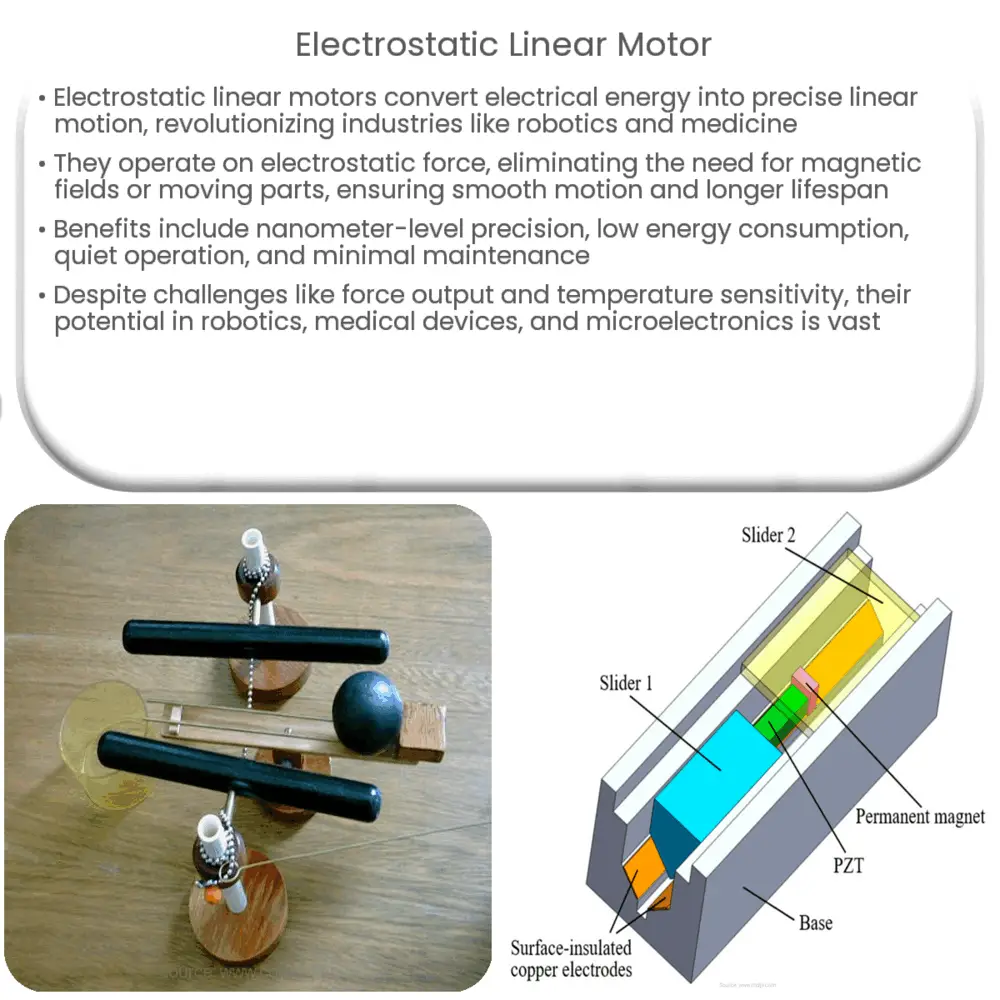Electrostatic linear motors provide high-precision, low-energy linear motion, ideal for robotics, medical devices, and microelectronics manufacturing.

Electrostatic Linear Motor: The Future of Motion Technology
Introduction
Electrostatic linear motors have been gaining attention in recent years due to their potential to revolutionize motion technology across various industries. These motors have the ability to convert electrical energy into linear mechanical motion with high precision, making them ideal for applications in fields such as robotics, medical devices, and manufacturing. In this article, we will explore the principles of electrostatic linear motors, their benefits, and their potential applications.
Working Principles of Electrostatic Linear Motors
Electrostatic linear motors work on the principle of electrostatic force, which is the force between charged particles. They consist of a stator, a stationary part that provides the electrical charge, and a slider, a movable part that responds to the charge. When an electric voltage is applied to the stator, it generates an electrostatic field, which interacts with the slider, causing it to move in a linear direction.
Unlike conventional electromagnetic motors, electrostatic linear motors do not rely on magnetic fields or moving parts such as gears or bearings. Instead, they operate using the force between electrically charged plates, which allows for smoother, more precise motion. The absence of mechanical components reduces friction and wear, resulting in a longer lifespan for the motor.
Advantages of Electrostatic Linear Motors
Electrostatic linear motors offer several advantages over traditional electromagnetic motors, including:
- Higher precision: Electrostatic linear motors can achieve nanometer-level precision in positioning, making them ideal for applications requiring extremely accurate motion control.
- Lower energy consumption: Due to the absence of mechanical components, electrostatic linear motors have lower energy consumption than their electromagnetic counterparts, contributing to energy efficiency.
- Quiet operation: Since there are no moving parts in the motor, electrostatic linear motors operate with minimal noise, making them suitable for use in noise-sensitive environments.
- Maintenance-free: The lack of wear-prone components in electrostatic linear motors means they require little to no maintenance, reducing the overall cost of ownership.
Potential Applications of Electrostatic Linear Motors
Due to their high precision and low energy consumption, electrostatic linear motors have the potential to be used in a wide range of applications, including:
- Robotics: Electrostatic linear motors can provide precise, high-speed motion control for robotic systems, enabling advanced automation in industries such as manufacturing and logistics.
- Medical devices: In the medical field, electrostatic linear motors can be utilized for precise positioning in diagnostic imaging systems, surgical instruments, and drug delivery devices.
- Microelectronics manufacturing: The nanometer-level precision of electrostatic linear motors makes them an ideal choice for the assembly and testing of microelectronic components, such as semiconductors and integrated circuits.
Challenges and Future Developments
Despite the numerous advantages and potential applications, electrostatic linear motors also face some challenges that need to be addressed to unlock their full potential:
- Force output: The force generated by electrostatic linear motors is typically lower than that of electromagnetic motors. Researchers are working on innovative designs and materials to increase force output without sacrificing precision or efficiency.
- Temperature sensitivity: Electrostatic forces can be affected by temperature variations, which may influence motor performance. Further research is needed to develop temperature-resistant designs and materials to ensure consistent performance under varying conditions.
- Cost: The fabrication and assembly of electrostatic linear motors can be more complex and expensive compared to conventional motors. However, as the technology matures and scales, it is expected that the costs will decrease and become more competitive with traditional motors.
Future developments in electrostatic linear motor technology will likely focus on addressing these challenges, as well as exploring new applications and integration possibilities with other emerging technologies, such as the Internet of Things (IoT) and artificial intelligence (AI).
Conclusion
Electrostatic linear motors hold great promise for a wide range of applications across various industries, thanks to their high precision, low energy consumption, and minimal noise operation. By overcoming the existing challenges and continuing to innovate in design and materials, electrostatic linear motors have the potential to revolutionize motion technology and become an integral part of next-generation robotics, medical devices, and microelectronics manufacturing.
As research and development efforts continue, electrostatic linear motors are expected to play an increasingly important role in driving advancements in technology and contributing to a more efficient, sustainable, and connected world.

